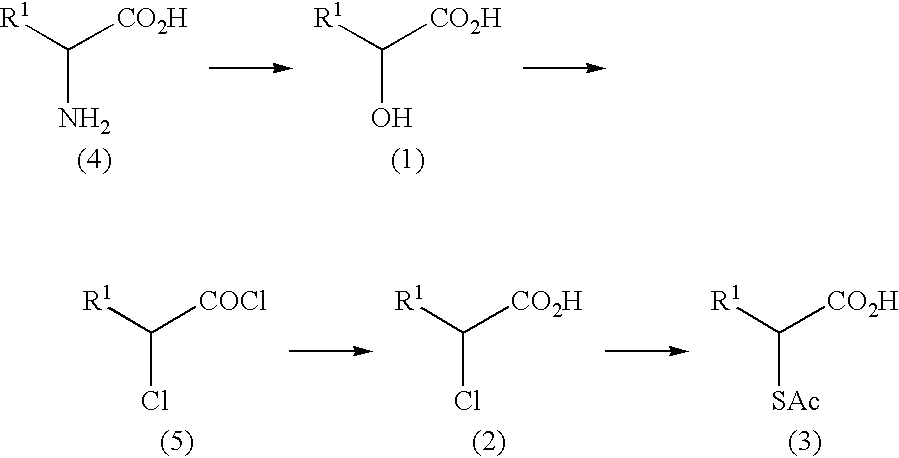Process for producing optically active carboxylic acid subtituted in 2-position
- Summary
- Abstract
- Description
- Claims
- Application Information
AI Technical Summary
Benefits of technology
Problems solved by technology
Method used
Image
Examples
example 1
Production of (2S)-2-hydroxy-3-phenylpropionic Acid
[0132] 11
[0133] L-Phenylalanine (10.00 g, 60.5 mmol) was added to a dilution of 8.88 g (90.5 mmol) of concentrated sulfuric acid in 110 g of water and then, at an inside temperature of 20.degree. C., a mixture of 10.45 g (151.5 mmol) of sodium nitrite and 20 g of water was added over 5 hours. After addition, the mixture was stirred at 20.degree. C. for 20 hours, 100 ml of t-butyl methyl ether was then added and, after 30 minutes of stirring at 20.degree. C., the organic phase was separated (extract 1). Further, 50 ml of t-butyl methyl ether was added to the aqueous phase, the mixture was stirred at 20.degree. C. for 30 minutes, and the organic phase was separated (extract 2). The extracts 1 and 2 were combined. The combined extract (116.5 g) contained 8.6 g of (2S)-2-hydroxy-3-phenylprop-ionic acid (yield 86%, optical purity 95.9% ee). The proton concentration (normality) in the reaction of this example was 1.7 mol / kg, the amount of...
example 2
Production of (2S)-2-hydroxy-3-phenylpropionic Acid
[0134] L-Phenylalanine (10.00 g, 60.5 mmol) was added to a dilution of 5.93 g (60.5 mmol) of concentrated sulfuric acid in 110 g of water and then, at an inside temperature of 20.degree. C., a mixture of 10.45 g (151.5 mmol) of sodium nitrite and 20 g of water was added over 5 hours. After addition, the mixture was further stirred at 20.degree. C. for 20 hours and, thereafter, the same work-up procedure as in Example 1 was followed. The combined extract (116.1 g) obtained contained 8.7 g of (2S)-2-hydroxy-3-phenylpropionic acid (yield 87%, optical purity 95.2% ee). The proton concentration (normality) in the reaction of this example was 1.1 mol / kg, the amount of the protonic acid was 2.0 equivalents (relative to L-phenylalanine), and the reaction temperature was 20.degree. C.
example 3
Production of (2S)-2-hydroxy-3-phenylpropionic Acid
[0135] L-Phenylalanine (10.00 g, 60.5 mmol) was added to a dilution of 4.15 g (42.4 mmol) of concentrated sulfuric acid in 110 g of water and then, at an inside temperature of 20.degree. C., a mixture of 10.45 g (151.5 mmol) of sodium nitrite and 20 g of water was added over 5 hours. After addition, the mixture was further stirred at 20.degree. C. for 20 hours and, thereafter, the same work-up procedure as in Example 1 was followed. The combined extract (115.8 g) obtained contained 8.7 g of (2S)-2-hydroxy-3-phenylpropionic acid (yield 87%, optical purity 92.0% ee). The proton concentration (normality) in the reaction of this example was 0.8 mol / kg, the amount of the protonic acid was 1.4 equivalents (relative to L-phenylalanine), and the reaction temperature was 20.degree. C.
PUM
| Property | Measurement | Unit |
|---|---|---|
| Length | aaaaa | aaaaa |
| Length | aaaaa | aaaaa |
| Length | aaaaa | aaaaa |
Abstract
Description
Claims
Application Information
 Login to View More
Login to View More - R&D
- Intellectual Property
- Life Sciences
- Materials
- Tech Scout
- Unparalleled Data Quality
- Higher Quality Content
- 60% Fewer Hallucinations
Browse by: Latest US Patents, China's latest patents, Technical Efficacy Thesaurus, Application Domain, Technology Topic, Popular Technical Reports.
© 2025 PatSnap. All rights reserved.Legal|Privacy policy|Modern Slavery Act Transparency Statement|Sitemap|About US| Contact US: help@patsnap.com



